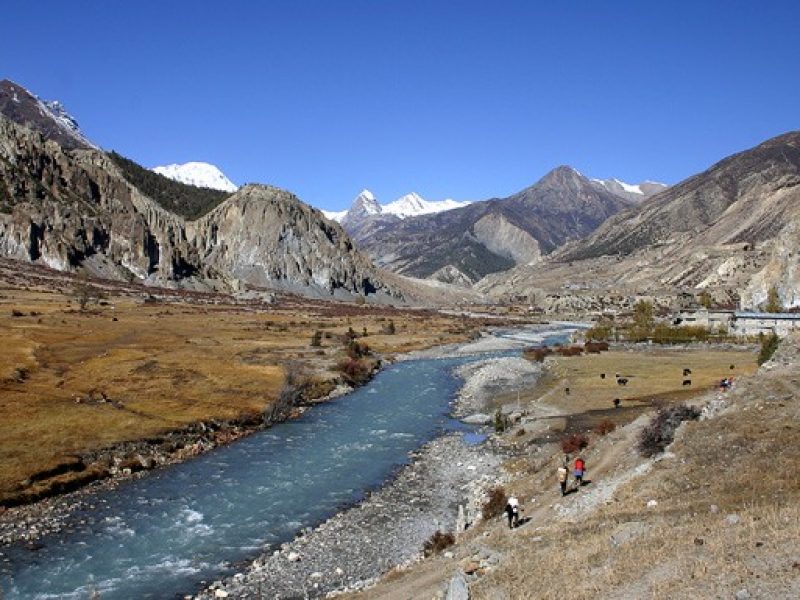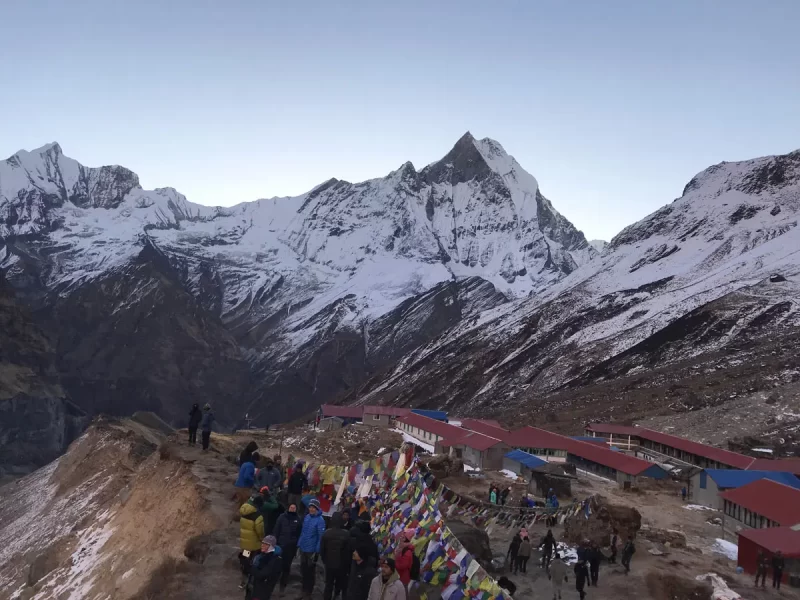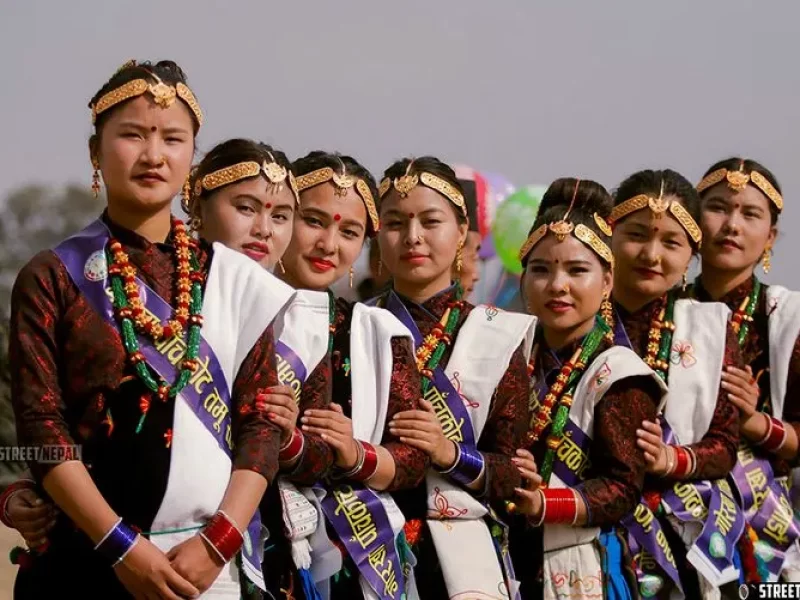Experience the vibrant lively culture and traditions of the Gurung people in the Annapurna region of Nepal. The Annapurna region offers a unique blend of stunning scenery, rich local cultures, and an immersive cultural experience, allowing visitors to immerse themselves in their unique lifestyle.
The Gurungs, a resilient community in Nepal’s Annapurna region, are known for their rich cultural heritage and diverse way of life. This is shaped by intricate customs, traditions, and beliefs.
The Gurung people, an indigenous ethnic group in Nepal, are known for their rich cultural heritage, strong sense of community, and deep connection to the Himalayan landscape. Originating from the Tibetan-Mongolian region, they migrated to central Nepal, particularly the Annapurna and Manaslu regions.
Generally, the Gurung society is organized into patrilineal clans, maintaining social cohesion through kinship ties and collective decision-making. They have their own distinct language, Gurung Kura, which is used in rural Gurung communities for communication and cultural expression.
Gurung culture is characterized by a vibrant tapestry of traditions and customs, deeply rooted in religious beliefs, agricultural practices, and seasonal rhythms. Festivals, traditional attire, music, dance, and cuisine reflect their cultural identity.
Despite their significant contributions to Nepalese society, the Gurung people face challenges such as poverty, limited access to education and healthcare, and the pressures of modernization and globalization. Recognizing and celebrating their cultural heritage is crucial for their continued flourishing.
Exploring Annapurna: Trekking Adventures, Cultural Riches And Natural Beauty
Firstly, Annapurna Nepal’s Himalayan region, known for its established trekking routes, diverse cultures, and stunning alpine scenery, attracts tourists and nature lovers worldwide. Annapurna offers diverse treks for all skill levels, including easy and strenuous adventures like the Annapurna Base Camp and Annapurna Circuit treks, which cover the entire Annapurna massif.
Trekkers encounter scenic settlements with rich cultural traditions, including Gurungs, Magars, and Thakalis, and teahouses and guesthouses provide lodging and hospitality for tired tourists.
The area boasts stunning natural beauty, including snow-capped peaks, lush forests, waterfalls, and terraced farms, making trekkers unforgettable with breathtaking views of famous mountains like Dhaulagiri, Machapuchare, and Annapurna.
Additionally, Annapurna offers a variety of outdoor activities like hiking, mountaineering, rock climbing, and whitewater rafting, attracting tourists seeking adventure and peace in nature.
When To Visit The Annapurna Region?
The Annapurna region in Nepal is known for its stunning landscapes, diverse culture, and world-class trekking routes. The best time to visit is autumn, which offers clear skies, mild temperatures, and stunning views of snow-capped peaks. 
Spring, from March to May, is characterized by mild temperatures, blooming rhododendrons, and longer daylight hours. However, spring is a popular tourist season, leading to higher accommodations and permit prices.
Winter, from December to February, brings cold temperatures and occasional snowfall, offering solitude and clear mountain views. Monsoon, from June to August, brings heavy rainfall, resulting in slippery trails and landslides.
While not recommended for trekking due to safety concerns and limited visibility, it can be a good time to explore the region’s cultural aspects. Moreover, rain shadow areas like Upper Mustang and Manang are suitable for trekking during this time.
History And Homeland Of Gurung People
- The Gurung people are from Nepal and live mostly in the Annapurna and Manaslu areas, which have lots of mountains and different kinds of land.
- Because they live far away from other places, the Gurungs have developed their own way of life that’s about being able to take care of themselves and being strong and flexible.
- Experts think that the Gurungs came from tribes in Tibet and Mongolia many years ago. They’ve stayed close with other groups nearby and with traders from Tibet.
- Living close to big roads where trade happens, the Gurungs have learned different things from different cultures, like Buddhism, Hinduism, and ways of other nearby groups.
- Things like when Nepal became one country under the Shah family and when the British ruled over Nepal have also changed the Gurungs’ lives.
Gurung Cultural Practices And Traditions
The Gurung people have a vibrant culture marked by colorful festivals, traditional attire, and lively music and dance. Their cultural practices and traditions are explained below:
1.Cultural Practices and Traditions
- The Gurung people follow special customs and traditions passed down from their ancestors.
- They celebrate festivals like Lhosar, Dashain, and Tihar with rituals, prayers, and get-togethers.
2.Traditional Clothing
- Gurung men wear something called a “Bakhu,” while women wear a “Guniu Cholo” and “Patuka” with skirts or “Paraschhain.”
- These clothes show who they are and are suitable for living in the mountains.

3.Music and Dance
- Music and dance are super important in Gurung culture.
- They use them to tell stories, connect with their spirits, and have fun together.
4.Spiritual Beliefs
- Gurung people believe in a mix of animism, Buddhism, and Hinduism, which is because Nepal has lots of different cultures.
5.Food
- Gurung food is simple, healthy, and made with local ingredients.
- They eat things like rice, maize, millet, lentils, veggies, and dairy products.
6.Community and Family
- Gurung families are organized into groups led by dads’ families.
- lastly, they stick together as a community and make decisions together to stay strong.
Facing Challenges And Protecting Gurung Culture
The Gurung culture, a traditional Gurung language and culture, is at risk of erosion due to rapid modernization, urbanization, and globalization. This has led to the migration of Gurung youth, resulting in the loss of traditional practices and values.

The language shift, dominated by Nepali, threatens the transmission of oral traditions and cultural values. External influences, such as Westernization and mass media, also pose a challenge to the preservation of Gurung culture.
The fragile Himalayan ecosystem, which sustains the livelihoods and cultural practices of the Gurung people, is threatened by deforestation, climate change, and unsustainable development.
Preservation efforts include cultural education programs, documentation and research, revival of traditional crafts, community-based tourism, and environmental conservation. These efforts aim to raise awareness about Gurung heritage, revive traditional crafts, and protect the Himalayan region’s biodiversity and ecological integrity.
Despite these challenges, the Gurung people are resilient in their efforts to preserve and promote their cultural heritage.
Conclusion
In conclusion, the Gurung culture in Nepal is a rich and resilient ethnic tapestry, celebrating its unique identity through language, festivals, attire, music, and spirituality. It is our collective responsibility to preserve and cherish this heritage for generations to come.
Trek Me Nepal offers trekking opportunities in the Annapurna region, allowing travelers to immerse themselves in the Gurung culture through responsible tourism practices. Discover the vibrant culture and traditions of the Gurung people in the Annapurna region of Nepal through Trek Me Nepal. By supporting initiatives like Trek Me Nepal, we contribute to the preservation of cultural heritage and the empowerment of local communities, allowing us to carry with us memories of the Gurung people.
Frequently Asked Questions (FAQs)
1. What are some key festivals celebrated by the Gurung community in the Annapurna region?
Gurung festivals include Lhosar (New Year), Tamu Losar, Dashain, Tihar, and Chandi Purnima. These festivals are marked by colorful processions, traditional dances, and communal feasting.
2. What is the traditional attire of the Gurung people?
Traditional Gurung attire for men includes the “Bakhu” (knee-length garment), “Suruwal” (baggy trousers), and “Topi” (cap), while women wear the “Guniu Cholo” (blouse), “Patuka” (waistband), and skirt or trousers.
3. What role do monasteries and sacred sites play in Gurung culture?
Monasteries (“Gompas”) and sacred sites hold great significance in Gurung spirituality, serving as places of worship, meditation, and communal gatherings. However, they are often associated with local deities and ancestral spirits.
4. How do Gurung people preserve their cultural heritage in the face of modernization?
Gurung communities engage in various preservation efforts, including cultural education programs, revival of traditional crafts, and community-based tourism initiatives.
5. What opportunities are available for travelers interested in experiencing Gurung culture in the Annapurna region?
Travelers can engage in cultural tours, homestays, and trekking experiences offered by local organizations like Trek Me Nepal. Therefore, these opportunities provide insights into Gurung traditions, festivals, and way of life.
6. What are some traditional foods of the Gurung people?
Generally, traditional Gurung cuisine includes dishes such as “Kodo ko Roti” (millet bread), “Gundruk” (fermented leafy greens), “Gurung Ko Masu” (spiced meat curry), and “Aloo Tama” (potato and bamboo shoot curry).
7. How do Gurung people pass down their cultural heritage to younger generations?
Gurung elders transmit cultural knowledge and values through storytelling, folk songs, rituals, and participation in traditional festivals and ceremonies. Additionally, efforts are made to incorporate cultural education into school curricula.
8. What environmental challenges do Gurung communities face in the Annapurna region?
Gurung communities face environmental challenges such as deforestation, climate change, and unsustainable development, which threaten their traditional livelihoods and the ecological integrity of their ancestral lands.

Comment (0)